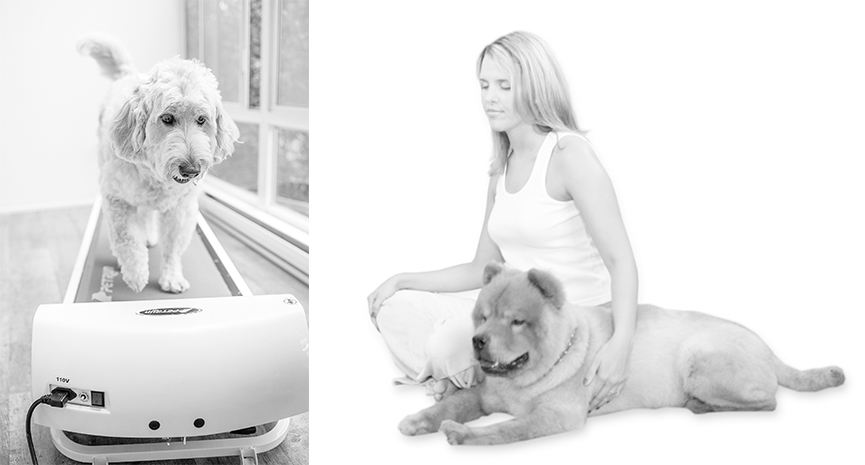Being a dog or cat in America these days is nice work if you can get it. Pet owners spring for gourmet kibble, canine couture and doggy daycare, where their animal companions can spend the day watching Animal Planet while being monitored by webcams for their parent’s viewing pleasure.
It’s no wonder then that our obsession with our four-legged friends has moved beyond the aisles of the local pet super store and is making us taking a big picture look at their health and quality of life.
The desire to treat our pets as our children has led to a boom in pet health and behavioral specialists–everything from doggie dermatologists to makers of pet prosthetics.
Here’s a look at some of the niche health services now available to your furry, feathered and scaled friends.
Pet Psychics – If you find yourself wondering whether Sgt. Slobber likes his kibble or if Mrs. Purrkins is satisfied with the litter box setup, consider checking in with your nearest animal communicator. These mediums advertise the ability to “talk” to animals of all stripes and feathers in order to help owners understand emotional, physical, mental and spiritual issues the pet might be experiencing.
There’s no crystal (tennis) ball needed, pet psychics talk to owners, tapping into the pet’s energy and helping owners solve problems ranging from biting dogs to lost cats–they might even teach you how to talk to your pets if you’re interested.
Spiritual Therapy – Most pet owners are happy to give their dog some flea medication and make sure their cat stays up to date on rabies shots, but what happens when their problems become a little more metaphysical? It might be time to give the nearest energy healer a call.
Reiki is a Japanese spiritual practice that is said to help reduce stress and promote healing, and it seems to be gaining traction in the pet community–with spiritual centers and shelters offering workshops for practitioners and plenty of websites and books touting its benefits.
Reiki masters lay their hands on or near a pet’s body to replenish the recipient’s “life force energy,” which helps bring spiritual and emotional balance to the recipient–whether it’s a human suffering from migraines or a dog who’s afraid of thunderstorms.
The site, AnimalHealings.com states “Using Reiki with pets, no matter what types of prescribed drug therapies and any other programs your pet may be on, Reiki can work side-by-side naturally with anything your vet or other pet care professionals may be utilizing.”
Physical Therapy – Whether your cat has developed a limp or your dog is recovering from surgery, now you can enlist the help of physical therapists or veterinarians who’ve received specialized training to help rehabilitate the family pet.
They employ many of the same techniques used on humans (in fact, many of the pet physical therapists out there also work with people) including things like manual therapy, cold laser therapy, sports conditioning and even underwater treadmills.
Physical therapy is one of the fastest growing specialties in veterinary medicine as more vets have started recognizing the benefits of rehab, and schools have begun offering training programs on the subject. While most of the training applies to dogs, it can be adapted for everything from cats to horses to rabbits.
Canine Hydrotherapy – Hydrotherapy allows animals that are recovering from surgery or soft tissue injuries or suffering from things like osteoarthritis and orthopedic or neurological conditions to improve muscle tone and promote tissue repair without putting unnecessary stress on their bones, tendons and joints. Not to mention, it’s a great form of general fitness–especially for overweight and obese dogs–improving cardiovascular health and muscle tone.
Think you can just lead your dog to the nearest swimming pool for a dip? Think again. Hydrotherapy experts say that the type of pool and water you should seek for your pet varies depending on their size and specific needs. Options available include underwater treadmills, hot tubs, and anti-swim jets and pools designed specifically for dog’s use. This often includes ramps rather than ladders or stairs for entry and exit.
Acupuncture – Another healing technique from the Far East, acupuncture is part of a family of procedures that uses thin metallic needles to stimulate different anatomical points and is most often used to treat chronic pain.
In China, it’s been used on animals for thousands of years and is becoming more widespread elsewhere, complementing the Western medicine used to treat sick pets and livestock. It can help with anything from musculoskeletal problems like arthritis to respiratory problems to allergies, according to the International Veterinary Acupuncture Society, which was chartered in 1974. Search for an animal acupuncturist by visiting the American Academy of Veterinary Acupuncture.
Pet Hospice – Finally, even when you’ve done all you can to rehabilitate and heal an ailing pet, you’ll inevitably be faced with the heart-wrenching decision to let go of your loyal friend.
To help you through this process many veterinarians and specialty clinics are offering hospice care–counseling clients on using medication to make their pets more comfortable and offering euthanasia in the comfort of your home. There is even a International Association for Animal Hospice and Palliative Care, which was founded in 2009, and now has more than 200 members
All this leaves us wondering how Old Yeller might have fared if he’d made it to 2015. He probably would’ve been up to date on his rabies vaccination. He might have lived to an old age, enjoying weekly swims in a heated pool or massage therapy to soothe his aching joints. And when it was his time to go, Travis wouldn’t have to go out back with a shotgun. He’d probably get to cuddle next to his beloved friend in front of the fireplace as a veterinarian helped him drift off to sleep. He would’ve deserved all that, too.





